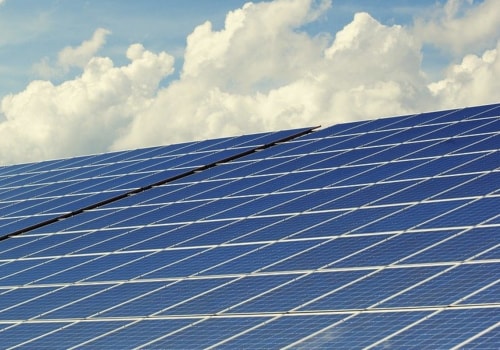While traditional energy sources are dispatchable and can supply energy when we need it, the sun's energy is intermittent and without storage, solar energy cannot supply electricity on demand. Solar panels have numerous advantages along with some disadvantages. The biggest advantage of solar panels is the fact that they are clean and carbon-free; they don't contribute to greenhouse gas emissions. Another important advantage of solar energy is that it is renewable; this form of energy is sustainable and literally infinite.
Other advantages of solar panels include, but are not limited to, their diverse application and their low maintenance costs. Solar panel installation is also creating new jobs in the renewable energy sector. On the other hand, one of the disadvantages of solar panels is that solar panels are climate-dependent. However, most panels come equipped with batteries that store electricity for later use.
Another drawback of solar panels is that, due to their low efficiency, they require large areas for installation; however, with the advancement of technology in this field, solar efficiency is expected to increase in the coming years.
solar energy
is a rapidly growing market, which should be good news for the environment. The replacement rate of solar panels is faster than expected and, given the current high recycling costs, there is a real danger that all used panels will go directly to landfill (along with equally difficult to recycle wind turbines). Regulators and industry players must begin to improve the economy and scale of recycling capacities before the solar panel flood hits.On the other hand, solar energy does not produce pollution. The abundant energy of the Sun is an unlimited source of energy that does not damage the ozone layer. Industrial solar energy systems are an investment in the future of the planet that can help maintain non-renewable energy sources and protect the environment. Today, solar energy conversion is widely used to generate heat and produce electricity.
A comparative study on global energy consumption published by the International Energy Agency (IEA) shows that by 2050, solar panel installations will supply about 45% of the world's energy demand. Solar thermal energy was found to be gaining notable popularity in industrial applications. Solar thermal energy is an alternative for generating electricity, processing chemicals or even heating spaces. Can be used in food, non-metallic, textile, construction, chemical, or even business-related industries.
On the other hand, solar electricity is widely applied in the telecommunications industry, agriculture, water desalination and construction to operate lights, pumps, motors, fans, coolers and water heaters. Another concern is that solar energy can occupy a significant amount of land and cause land degradation or habitat loss for wildlife. While solar photovoltaic systems can be attached to existing structures, larger utility scale photovoltaic systems may require 3.5 to 10 acres per megawatt and CSP installations require between 4 and 16.5 acres per megawatt. However, the impact can be reduced by placing facilities in low-quality areas or along existing transport and transmission corridors.
In the late 1970s, it wasn't obvious that the U.S. solar industry was in danger. President Jimmy Carter and Congress had just established the Department of Energy, which promised to develop new energy technologies with the same seriousness as the U.S. UU.
It is dedicated to the development of new military technologies. Solar engineers saw a bright future. But then, a series of changes affected the US economy. The Federal Reserve raised interest rates to record highs, making it difficult for Americans to obtain auto loans, while strengthening the dollar against other currencies, making it difficult for U.S.
exporters to sell goods abroad. Presidents Carter and Ronald Reagan relaxed the rules against “corporate incursions,” allowing Wall Street merchants to force companies to close or spin-off part of their businesses. After 1980, Reagan also weakened federal environmental regulations by dismantling the new Department of Energy, eliminating support for alternative energy sources, such as solar energy. India's climate is very sustainable and relaxed compared to other countries, and mostly sunny, which is the best source for the working process of solar panels.
These solar cells are formed of silicon semiconductors that consist of a negative layer and a positive layer opposite each other. Because installing solar panels increases the value of your home, you can also increase your property taxes. Solar energy can reduce energy costs and increase productivity, and its benefits can be seen in as little as three years. And Japan's willingness to ship quickly and imperfectly eventually helped it develop solar energy at utility scale.
The United States, the country that once produced all of the world's solar panels, saw its market share fall. There has been a lot of talk about the usefulness and ingenuity of these solar panels; and the panels have been presented as the gateway to conventional energy. In addition, while concentrating solar thermal plants (CSPs) are comparatively inefficient in their use of water depending on the type of technology being used, the right technology significantly increases efficiency, while photovoltaic (PV) solar cells do not require water to generate electricity. There are many types of equipment suppliers, some of them are solar panel mounts, roof mounts, brackets and silicone molds.
This is another reason to enjoy the advantages of solar energy, especially if industrial facilities are located in an area with good climatic conditions that allow a good extraction of this type of energy. Solar energy can be used to generate heat for a wide variety of industrial applications, including water desalination, improved oil recovery, food processing, chemical production and mineral processing, among many others. Solar energy technology is becoming an increasingly cost-competitive alternative to fossil fuels, although it remains somewhat expensive in certain markets. Solar energy is a 100% clean and renewable energy source that reduces dependence on oil, coal and natural gas for electricity production.
In recent years, solar panels have dropped in price and now offer benefits to organizations like yours. However, problems with solar energy, namely, expensive cost and inconsistent availability, have prevented it from becoming a more widely used source of energy. . .







